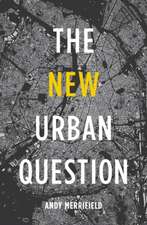Spatial Regulation in New York City: From Urban Renewal to Zero Tolerance: Routledge Advances in Geography
Autor Themis Chronopoulosen Limba Engleză Paperback – 23 mai 2013
| Toate formatele și edițiile | Preț | Express |
|---|---|---|
| Paperback (1) | 484.47 lei 6-8 săpt. | |
| Taylor & Francis – 23 mai 2013 | 484.47 lei 6-8 săpt. | |
| Hardback (1) | 1114.64 lei 6-8 săpt. | |
| Taylor & Francis – 7 feb 2011 | 1114.64 lei 6-8 săpt. |
Preț: 484.47 lei
Nou
Puncte Express: 727
Preț estimativ în valută:
92.72€ • 96.44$ • 76.54£
92.72€ • 96.44$ • 76.54£
Carte tipărită la comandă
Livrare economică 14-28 aprilie
Preluare comenzi: 021 569.72.76
Specificații
ISBN-13: 9780415850797
ISBN-10: 0415850797
Pagini: 244
Ilustrații: 20 b/w images and 20 halftones
Dimensiuni: 152 x 229 x 13 mm
Greutate: 0.33 kg
Ediția:1
Editura: Taylor & Francis
Colecția Routledge
Seria Routledge Advances in Geography
Locul publicării:Oxford, United Kingdom
ISBN-10: 0415850797
Pagini: 244
Ilustrații: 20 b/w images and 20 halftones
Dimensiuni: 152 x 229 x 13 mm
Greutate: 0.33 kg
Ediția:1
Editura: Taylor & Francis
Colecția Routledge
Seria Routledge Advances in Geography
Locul publicării:Oxford, United Kingdom
Public țintă
Postgraduate and UndergraduateCuprins
Introduction 1. The Betrayal of the Liberal Assumptions of Urban Renewal 2. The Failure of Urban Renewal as a Spatial Ordering Apparatus 3. Times Square: New York’s Most Disorderly Place 4. Neoliberalism, Neoconservatism, and Spatial Regulation 5. Graffiti as a Manifestation of Social Disorder 6. The Declining Appearance of Order, 1978-1993 7. The Radicalization of Spatial Regulation, 1994-2001. Epilogue: The Legacy of Displacement and Exclusion
Descriere
This book explores and critiques the process of spatial regulation in post-war New York, focusing on the period after the fiscal crisis of the 1970s, examining the ideological underpinnings and practical applications of urban renewal, exclusionary zoning, anti-vagrancy laws, and order-maintenance policing. It argues that these practices were part of a class project that deflected attention from the underlying causes of poverty, eroded civil rights and sought to enable real estate investment, high-end consumption, mainstream tourism, and corporate success.




























